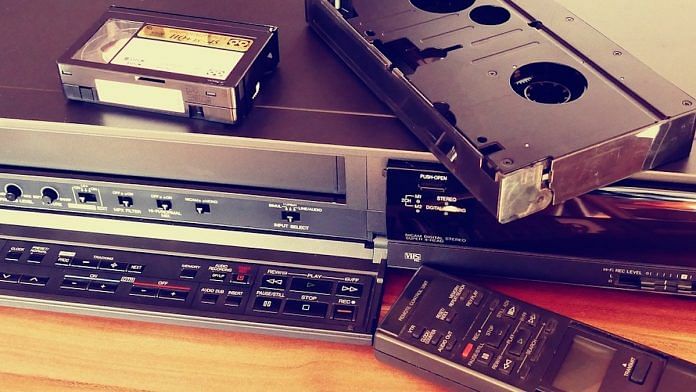Decades before private entertainment technology took a sudden giant leap, middle-class Indian homes had the video cassette recorder – or the VCR – in the 1980s and the early 1990s.
Owning a VCR – a flat box-like instrument — was a statement in itself. You were telling others that you weren’t just relying on Doordarshan and AIR at home. You had other means of entertainment. But more importantly, you were conveying that you could also access Hollywood movies.
You could skip the process of stepping out with your family to go watch movies in the cinema halls by jostling for tickets at the crowded hole-in-the-wall counters or with those selling them in black. You could enjoy it sitting at home. And if you were lucky and had an understanding with your neighbourhood ‘video lending library’, you would get the latest movies – pirated of course – within a couple of days. The rental shop in the neighbourhood market was the hub of weekend entertainment. The shopkeeper would tell you what is being watched by other people in the area – a kind of crude, word-of-mouth alert on what was ‘viral-ing’ – and you knew you had to book it too. That Grammy Awards video cassette, the Rolling Stones Live concert, the Michael Jackson tour that you learned about from the rental place.
“It was the most prized possession for families,” said brand guru Harish Bijoor. “It was an experience for the rich,” echoed advertising and marketing expert Santosh Sood.
“It brought entertainment into your homes, it gave you flexibility and you could watch a movie at a time convenient to you without stepping into theatres, which were dingy and dirty during those days,” Sood added.
Also read: Devil’s in the detail: How Onida TV became a household name in the ’80s
But the VCR brought in another trend. It introduced pornography into Indian homes, at a time when watching a “blue film” was considered taboo and a hush-hush affair.
“You could watch a movie multiple times, stop it midway, restart, rewind and even fast forward…it was a great experience considering movie watching on television never gave that experience,” Bijoor said.
Blue films, until then, were shown only in the morning shows of shady cinema halls. It wasn’t a respectable thing to be seen milling about these halls. And it was a strict no-go area for women.
“In that sense, it brought in a huge social change and pornography was no more a domain of men,” Bijoor added. It was an India which was gradually shedding its older practices and prejudices. Coy honeymooning couples in hill stations would throng these rental libraries.
The VCR also, for the first time, allowed people to record their weddings or other functions. Watching the marriage and reception party on video was a ritual for every family. It was one way that the exhausted families recovered from the Big Fat Indian Wedding.
The VCR – available primarily in two variants—Betamax and VHS (video home system) — had a huge market and tech giants including Panasonic, Sony, Sanyo and Philips among others cashed in on this.
Also read: Photography for all: The Hot Shot camera changed the way Indians clicked
By the late 1980s, a poor man’s VCR came into the markets—the VCP or the video cassette player. This was a video player that did not have the option of recording. ‘Watching video’ at home was no more restricted to the rich and urban.
“Something that was considered an ultra-luxurious experience lost its sheen and almost became an unbearable thing, especially with the quality of cassettes dropping,” Sood pointed out.
Technology has its own life cycle and with each passing day, it gets shorter. The VCR had to die with the advent of CD and DVD players. Eventually, one had the Blu Ray players –which looked slick and had many upgraded and modern features. Today, even that seems to be losing steam with television sets being connected to the Internet and online streaming platforms directly.
Also read: Phantom comics to political exposés: How Illustrated Weekly became a must-read




Brings back pleasant memories. Our elder son was fond of watching Shahenshah on the VCR. Wife would switch it on and he would feed himself without fuss. The film had some memorable dialogues. Khaana khaane ke baad tip dena toh ek rivaaz hai. Pehle dena, acchi service ki guarantee …